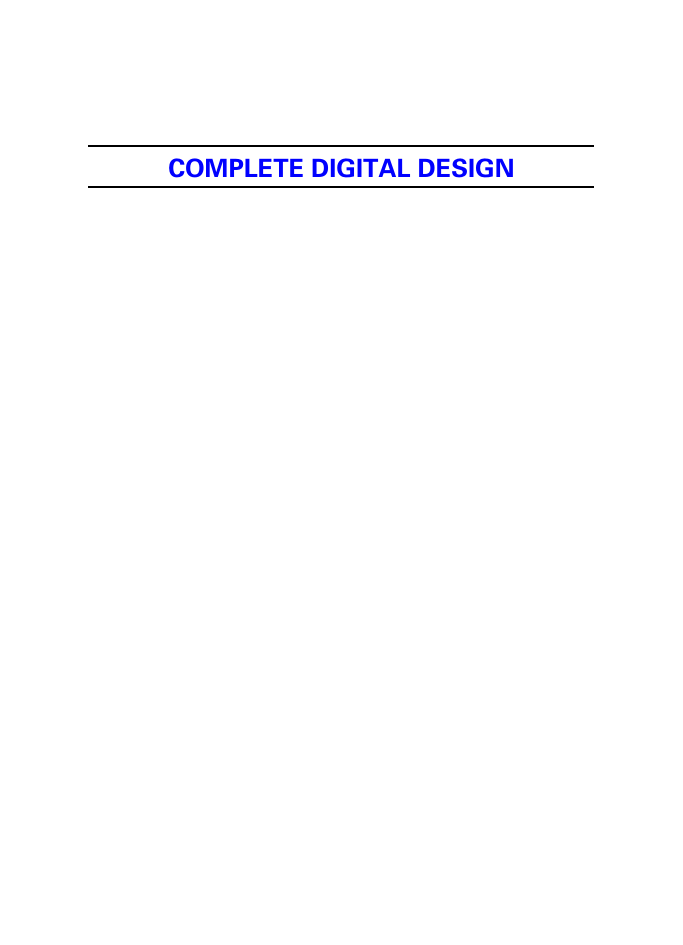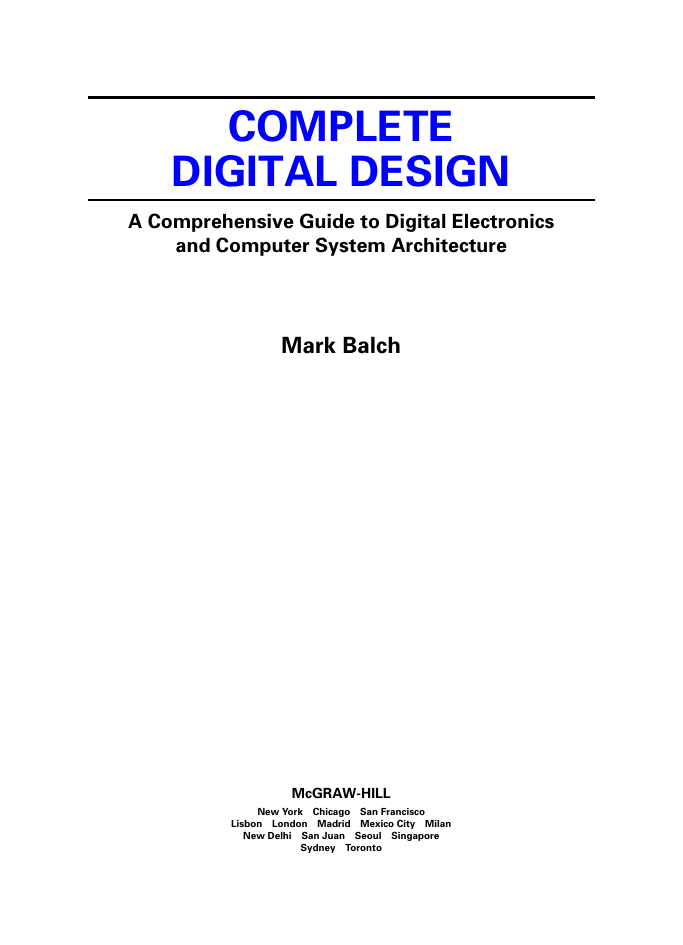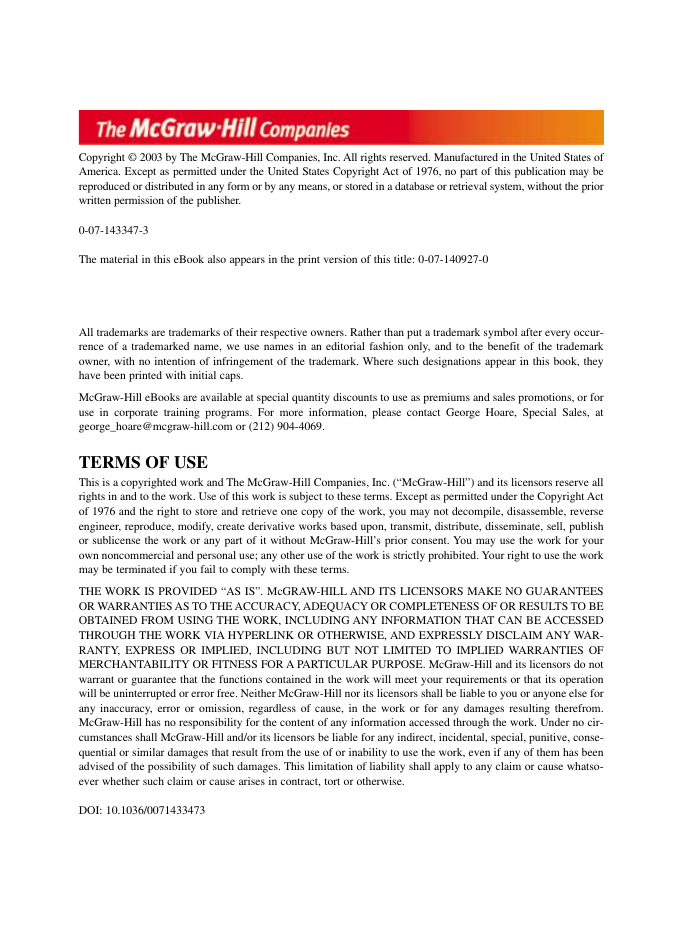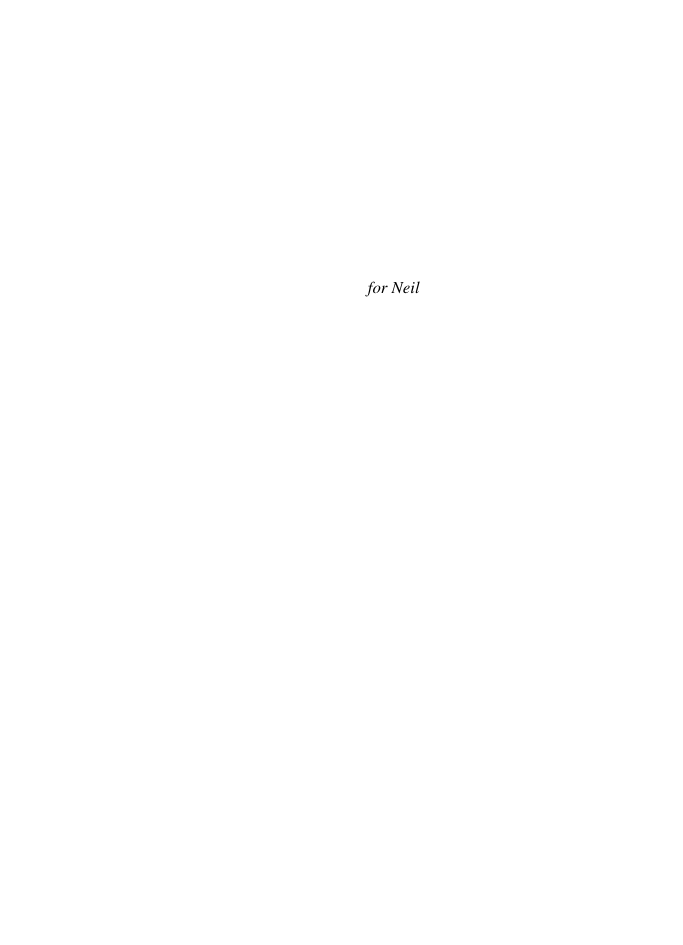COMPLETE
DIGITAL DESIGN
COMPLETE
DIGITAL DESIGN
Copyright
CONTENTS
PREFACE
ACKNOWLEDGMENTS
ABOUT THE AUTHOR
PART 1 Digital Fundamentals
Chapter 1 Digital Logic
1.1 BOOLEAN LOGIC
1.2 BOOLEAN MANIPULATION
1.3 THE KARNAUGH MAP
1.4 BINARY AND HEXADECIMAL NUMBERING
1.5 BINARY ADDITION
1.6 SUBTRACTION AND NEGATIVE NUMBERS
1.7 MULTIPLICATION AND DIVISION
1.8FLIP- FLOPS AND LATCHES
1.9 SYNCHRONOUS LOGIC
1.10 SYNCHRONOUS TIMING ANALYSIS
1.11 CLOCK SKEW
1.12 CLOCK JITTER
1.13 DERIVED LOGICAL BUILDING BLOCKS
Chapter 2 Integrated Circuits and the 7400 Logic Families
2.1 THE INTEGRATED CIRCUIT
2.2 IC PACKAGING
2.3 THE 7400- SERIES DISCRETE LOGIC FAMILY
2.4 APPLYING THE 7400 FAMILY TO LOGIC DESIGN
2.5 SYNCHRONOUS LOGIC DESIGN WITH THE 7400 FAMILY
2.6 COMMON VARIANTS OF THE 7400 FAMILY
2.7 INTERPRETING A DIGITAL IC DATA SHEET
Chapter 3 Basic Computer Architecture
3.1 THE DIGITAL COMPUTER
3.2 MICROPROCESSOR INTERNALS
3.3 SUBROUTINES AND THE STACK
3.4 RESET AND INTERRUPTS
3.5 IMPLEMENTATION OF AN EIGHT- BIT COMPUTER
3.6 ADDRESS BANKING
3.7 DIRECT MEMORY ACCESS
3.8EXTENDING THE MICROPROCESSOR BUS
3.9 ASSEMBLY LANGUAGE AND ADDRESSING MODES
Chapter 4 Memory
4.1 MEMORY CLASSIFICATIONS
4.2 EPROM
4.3 FLASH MEMORY
4.4 EEPROM
4.5 ASYNCHRONOUS SRAM
4.6 ASYNCHRONOUS DRAM
4.7 MULTIPORT MEMORY
4.8THE FIFO
Chapter 5 Serial Communications
5.1 SERIAL VS. PARALLEL COMMUNICATION
5.2 THE UART
5.3 ASCII DATA REPRESENTATION
5.4 RS- 232
5.5 RS- 422
5.6 MODEMS AND BAUD RATE
5.7 NETWORK TOPOLOGIES
5.8NETWORK DATA FORMATS
5.9 RS- 485
5.10 A SIMPLE RS- 485 NETWORK
5.11 INTERCHIP SERIAL COMMUNICATIONS
Chapter 6 Instructive Microprocessors and Microcomputer Elements
6.1 EVOLUTION
6.2 MOTOROLA 6800 EIGHT- BIT MICROPROCESSOR FAMILY
6.3 INTEL 8051 MICROCONTROLLER FAMILY
6.4 MICROCHIP PIC MICROCONTROLLER FAMILY
6.5 INTEL 8086 16- BIT MICROPROCESSOR FAMILY
6.6 MOTOROLA 68000 16/ 32- BIT MICROPROCESSOR FAMILY
PART 2 Advanced Digital Systems
Chapter 7 Advanced Microprocessor Concepts
7.1 RISC AND CISC
7.2 CACHE STRUCTURES
7.3 CACHES IN PRACTICE
7.4 VIRTUAL MEMORY AND THE MMU
7.5 SUPERPIPELINED AND SUPERSCALAR ARCHITECTURES
7.6 FLOATING- POINT ARITHMETIC
7.7 DIGITAL SIGNAL PROCESSORS
7.8PERFORMANCE METRICS
Chapter 8 High-Performance Memory Technologies
8.1 SYNCHRONOUS DRAM
8.2 DOUBLE DATA RATE SDRAM
8.3 SYNCHRONOUS SRAM
8.4 DDR AND QDR SRAM
8.5 CONTENT ADDRESSABLE MEMORY
Chapter 9 Networking
9.1 PROTOCOL LAYERS ONE AND TWO
9.2 PROTOCOL LAYERS THREE AND FOUR
9.3 PHYSICAL MEDIA
9.4 CHANNEL CODING
9.5 8B10B CODING
9.6 ERROR DETECTION
9.7 CHECKSUM
9.8CYCLIC REDUNDANCY CHECK
9.9 ETHERNET
Chapter 10 Logic Design and Finite State Machines
10.1 HARDWARE DESCRIPTION LANGUAGES
10.2 CPU SUPPORT LOGIC
10.3 CLOCK DOMAIN CROSSING
10.4 FINITE STATE MACHINES
10.5 FSM BUS CONTROL
10.6 FSM OPTIMIZATION
10.7 PIPELINING
Chapter 11 Programmable Logic Devices
11.1 CUSTOM AND PROGRAMMABLE LOGIC
11.2 GALS AND PALS
11.3 CPLDS
11.4 FPGAS
PART 3 Analog Basics for Digital Systems
Chapter 12 Electrical Fundamentals
12.1 BASIC CIRCUITS
12.2 LOOP AND NODE ANALYSIS
12.3 RESISTANCE COMBINATION
12.4 CAPACITORS
12.5 CAPACITORS AS AC ELEMENTS
12.6 INDUCTORS
12.7 NONIDEAL RLC MODELS
12.8FREQUENCY DOMAIN ANALYSIS
12.9 LOWPASS AND HIGHPASS FILTERS
12.10 BANDPASS AND BAND- REJECT FILTERS
12.11 TRANSFORMERS
Chapter 13 Diodes and Transistors
13.1 DIODES
13.2 POWER CIRCUITS WITH DIODES
13.3 DIODES IN DIGITAL APPLICATIONS
13.4 BIPOLAR JUNCTION TRANSISTORS
13.5 DIGITAL AMPLIFICATION WITH THE BJT
13.6 LOGIC FUNCTIONS WITH THE BJT
13.7 FIELD- EFFECT TRANSISTORS
13.8POWER FETS AND JFET S
Chapter 14 Operational Amplifiers
14.1 THE IDEAL OP- AMP
14.2 CHARACTERISTICS OF REAL OP- AMPS
14.3 BANDWIDTH LIMITATIONS
14.4 INPUT RESISTANCE
14.5 SUMMATION AMPLIFIER CIRCUITS
14.6 ACTIVE FILTERS
14.7 COMPARATORS AND HYSTERESIS
Chapter 15 Analog Interfaces for Digital Systems
15.1 CONVERSION BETWEEN ANALOG AND DIGITAL DOMAINS
15.2 SAMPLING RATE AND ALIASING
15.3 ADC CIRCUITS
15.4 DAC CIRCUITS
15.5 FILTERS IN DATA CONVERSION SYSTEMS
PART 4 Digital System Design in Practice
Chapter 16 Clock Distribution
16.1 CRYSTAL OSCILLATORS AND CERAMIC RESONATORS
16.2 LOW- SKEW CLOCK BUFFERS
16.3 ZERO- DELAY BUFFERS: THE PLL
16.4 FREQUENCY SYNTHESIS
16.5 DELAY- LOCKED LOOPS
16.6 SOURCE- SYNCHRONOUS CLOCKING
Chapter 17 Voltage Regulation and Power Distribution
17.1 VOLTAGE REGULATION BASICS
17.2 THERMAL ANALYSIS
17.3 ZENER DIODES AND SHUNT REGULATORS
17.4 TRANSISTORS AND DISCRETE SERIES REGULATORS
17.5 LINEAR REGULATORS
17.6 SWITCHING REGULATORS
17.7 POWER DISTRIBUTION
17.8ELECTRICAL INTEGRITY
Chapter 18 Signal Integrity
18.1 TRANSMISSION LINES
18.2 TERMINATION
18.3 CROSSTALK
18.4 ELECTROMAGNETIC INTERFERENCE
18.5 GROUNDING AND ELECTROMAGNETIC COMPATIBILITY
18.6 ELECTROSTATIC DISCHARGE
Chapter 19 Designing for Success
19.1 PRACTICAL TECHNOLOGIES
19.2 PRINTED CIRCUIT BOARDS
19.3 MANUALLY WIRED CIRCUITS
19.4 MICROPROCESSOR RESET
19.5 DESIGN FOR DEBUG
19.6 BOUNDARY SCAN
19.7 DIAGNOSTIC SOFTWARE
19.8SCHEMATIC CAPTURE AND SPICE
19.9 TEST EQUIPMENT
Appendix A Further Education
INDEX
















 2023年江西萍乡中考道德与法治真题及答案.doc
2023年江西萍乡中考道德与法治真题及答案.doc 2012年重庆南川中考生物真题及答案.doc
2012年重庆南川中考生物真题及答案.doc 2013年江西师范大学地理学综合及文艺理论基础考研真题.doc
2013年江西师范大学地理学综合及文艺理论基础考研真题.doc 2020年四川甘孜小升初语文真题及答案I卷.doc
2020年四川甘孜小升初语文真题及答案I卷.doc 2020年注册岩土工程师专业基础考试真题及答案.doc
2020年注册岩土工程师专业基础考试真题及答案.doc 2023-2024学年福建省厦门市九年级上学期数学月考试题及答案.doc
2023-2024学年福建省厦门市九年级上学期数学月考试题及答案.doc 2021-2022学年辽宁省沈阳市大东区九年级上学期语文期末试题及答案.doc
2021-2022学年辽宁省沈阳市大东区九年级上学期语文期末试题及答案.doc 2022-2023学年北京东城区初三第一学期物理期末试卷及答案.doc
2022-2023学年北京东城区初三第一学期物理期末试卷及答案.doc 2018上半年江西教师资格初中地理学科知识与教学能力真题及答案.doc
2018上半年江西教师资格初中地理学科知识与教学能力真题及答案.doc 2012年河北国家公务员申论考试真题及答案-省级.doc
2012年河北国家公务员申论考试真题及答案-省级.doc 2020-2021学年江苏省扬州市江都区邵樊片九年级上学期数学第一次质量检测试题及答案.doc
2020-2021学年江苏省扬州市江都区邵樊片九年级上学期数学第一次质量检测试题及答案.doc 2022下半年黑龙江教师资格证中学综合素质真题及答案.doc
2022下半年黑龙江教师资格证中学综合素质真题及答案.doc